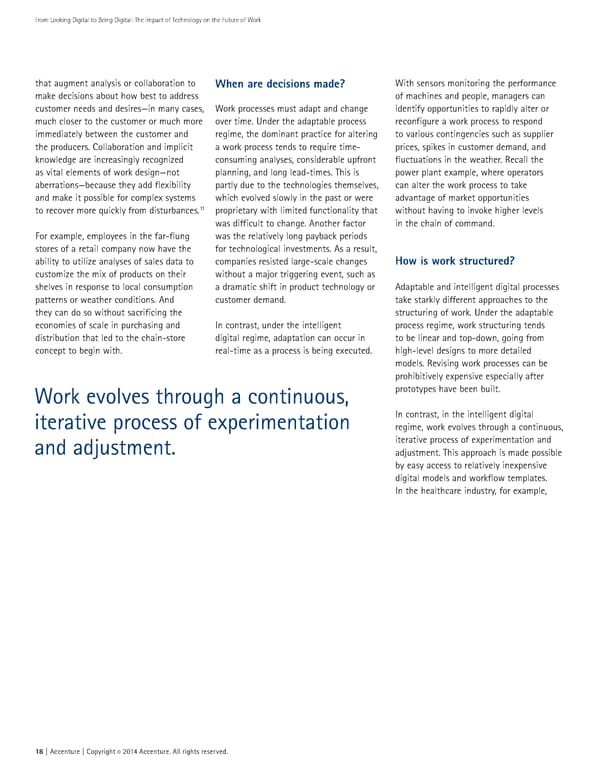From Looking Digital to Being Digital: The Impact of Technology on the Future of Work that augment analysis or collaboration to When are decisions made? With sensors monitoring the performance make decisions about how best to address of machines and people, managers can customer needs and desires—in many cases, Work processes must adapt and change identify opportunities to rapidly alter or much closer to the customer or much more over time. Under the adaptable process reconfigure a work process to respond immediately between the customer and regime, the dominant practice for altering to various contingencies such as supplier the producers. Collaboration and implicit a work process tends to require time- prices, spikes in customer demand, and knowledge are increasingly recognized consuming analyses, considerable upfront fluctuations in the weather. Recall the as vital elements of work design—not planning, and long lead-times. This is power plant example, where operators aberrations—because they add flexibility partly due to the technologies themselves, can alter the work process to take and make it possible for complex systems which evolved slowly in the past or were advantage of market opportunities 11 to recover more quickly from disturbances. proprietary with limited functionality that without having to invoke higher levels was difficult to change. Another factor in the chain of command. For example, employees in the far-flung was the relatively long payback periods stores of a retail company now have the for technological investments. As a result, ability to utilize analyses of sales data to companies resisted large-scale changes How is work structured? customize the mix of products on their without a major triggering event, such as shelves in response to local consumption a dramatic shift in product technology or Adaptable and intelligent digital processes patterns or weather conditions. And customer demand. take starkly different approaches to the they can do so without sacrificing the structuring of work. Under the adaptable economies of scale in purchasing and In contrast, under the intelligent process regime, work structuring tends distribution that led to the chain-store digital regime, adaptation can occur in to be linear and top-down, going from concept to begin with. real-time as a process is being executed. high-level designs to more detailed models. Revising work processes can be prohibitively expensive especially after Work evolves through a continuous, prototypes have been built. iterative process of experimentation In contrast, in the intelligent digital regime, work evolves through a continuous, and adjustment. iterative process of experimentation and adjustment. This approach is made possible by easy access to relatively inexpensive digital models and workflow templates. In the healthcare industry, for example, 18 | Accenture | Copyright 2014 Accenture. All rights reserved. ©
 From Looking Digital to Being Digital Page 16 Page 18
From Looking Digital to Being Digital Page 16 Page 18